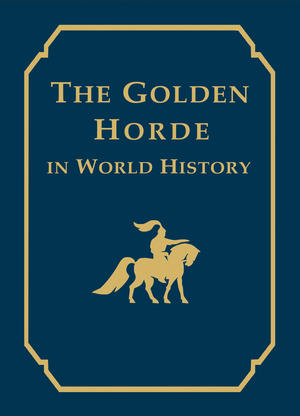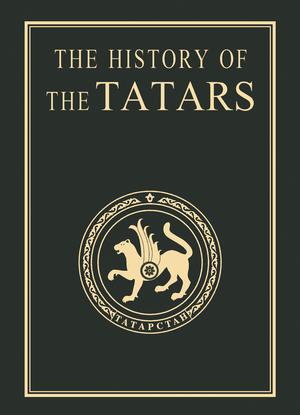
Читать
Скачать
Научный журнал
Средневековые тюрко-татарские государства. 2017. № 9
Казань: Институт истории им. Ш.Марджани АН РТ
2017
Средневековые тюрко-татарские государства. 2017. № 9
Казань: Институт истории им. Ш.Марджани АН РТ
2017
В новом номере научного журнала мы решили не ограничиваться только постзолотоордынским временем и представили материалы, выходящие за рамки этого исторического периода, а также постарались обрадовать публикациями представителей различных областей гуманитарных наук. Двигаясь в направлении превращения научного ежегодника в журнал, также ввели новые разделы «История и современность» и «In memoriam», предполагающие разговор (и дискуссии) о тенденциях и достижениях развития современной исторической науки и возрождении исторической памяти.

Читать
Скачать
Научный журнал
Из истории и культуры народов Среднего Поволжья. 2017. № 7
Казань: Институт истории им. Ш.Марджани АН РТ
2017
Из истории и культуры народов Среднего Поволжья. 2017. № 7
Казань: Институт истории им. Ш.Марджани АН РТ
2017
Доброй традицией нашего журнала становится публикация материалов научных семинаров, посвященных конкретным проблемам, что позволяет привлечь к обсуждению ведущих специалистов, которые знакомят своих коллег новыми открытиями, и сделать издание в определенной степени «тематическим». Формат журнала позволяет оперативно доводить до читателя новую научную информацию, чем мы воспользовались и на этот раз, разместив материалы сразу двух научных мероприятий.

Читать
Скачать
Под общ. ред. Л.Р.Габдрафиковой
Частные миры Великой русской революции. Сборник научных трудов (на русском и татарском языках)
Казань: Институт истории им. Ш.Марджани АН РТ
2017
Частные миры Великой русской революции. Сборник научных трудов (на русском и татарском языках)
Казань: Институт истории им. Ш.Марджани АН РТ
2017
В сборнике представлены научные статьи, подготовленные в рамках проведения Международной научной конференции «Частные миры Великой русской революции», приуроченной к 100-летию революции 1917 г. (Казань, 28–29 сентября 2017 г.). Особое внимание уделяется вопросам частной жизни, частной собственности, взаимодействия общества и власти, истории повседневности, а так же историческим биографиям и эго-документам революционного периода (дневников, писем, воспоминаний). Сборник рассчитан на специалистов, аспирантов и студентов, а также на всех, кто интересуется историей России.

Читать
Скачать
Коллектив авторов; под ред. Л.Р. Габдрафиковой; предисл. Р.С. Хакимова
Человек в революции: Казанская губерния: в 2-х томах. Т.2. 1917 г.
Казань: Институт истории им. Ш.Марджани АН РТ
2017
Человек в революции: Казанская губерния: в 2-х томах. Т.2. 1917 г.
Казань: Институт истории им. Ш.Марджани АН РТ
2017
В монографии представлен историко-антропологический анализ жизни многонационального населения Казанской губернии в 1917 г.: взаимодействие индивида с представителями старой и новой власти, перемены в массовом сознании, социальные реакции на материальные трудности, взаимоотношения в трудовых и учебных коллективах, сельской общине, положение семьи и женщин, проблемы вынужденных мигрантов войны в губернском обществе. Изменившаяся общественная иерархия и трансформация системы власти в губернии обострили внутренние противоречия и породили конфликты, как между различными социальными группами, так и внутри сообществ. В контексте символики власти особое внимание уделяется истории Казанского кремля. Исследование базируется на новейших методологических подходах и неопубликованных документальных источниках, в том числе материалах личного происхождения. Монография рассчитана на специалистов, аспирантов и студентов, а также на всех, кто интересуется историей России и Поволжья.

Читать
Скачать
Воронцов В.А.
О театре волжских булгар и природе театрального искусства
Казань: Центр инновационных технологий
2017
О театре волжских булгар и природе театрального искусства
Казань: Центр инновационных технологий
2017
Данная монография посвящена широкому кругу вопросов, связанных с природой театра: первой маске, истокам пантомимы, оборотничества, исходной форме театрального действа, её роли в психогенезе, социогенезе и культурогенезе. С учётом традиций тюркского театрального искусства произведён анализ «чудесных видений» в Волжской Булгарии, которые нашли отражение в отчёте секретаря багдадского посольства Ибн-Фадлана, посетившего эту страну на заре её исламизации, а также в других исторических источниках. Результаты анализа позволяют говорить о существовании при дворе булгарского правителя профессионального театра. Полученные результаты обеспечивают более адекватное прочтение важнейших исторических источников. Они проливают свет на истоки духовной жизни древних болгар и многих других этносов. Графические иллюстрации, выполненные автором, знакомят с методами реконструкции мифических и сказочных персонажей. Адресуется широкому кругу исследователей, преподавателей и соискателей – всем, кто интересуется истоками театрального искусства, а также культурой древних булгар.

Читать
Скачать
Перевод с персидского: И.Р.Гибадуллин, М.Р.Шамсимухаметова; комментарии: Д.А.Шагавиев, И.Р.Гибадуллин, А.А.Хасавнех, М.М.Якубович
Комментарии к «Каландар-наме» Абу Бакра Каландара Руми. Выпуск 1
Институт истории им. Ш.Марджани АН РТ
2017
Комментарии к «Каландар-наме» Абу Бакра Каландара Руми. Выпуск 1
Институт истории им. Ш.Марджани АН РТ
2017
Данное издание служит началом целой серии комментариев к отдельным главам «Каландар-наме» – произведения персоязычного суфийского автора Абу Бакра Каландара Руми, жившего в первой половине XIV века на территории Золотой Орды.

Читать
Скачать
Пер. с перс. И.Р.Гибадуллина, М.Р.Шамсимухаметовой; общая и научная редакция, предисловие, комментарии И.Р.Гибадуллина
Абу Бакр Каландар Руми. Каландар-наме: избранное
Институт истории им. Ш.Марджани АН РТ
2017
Абу Бакр Каландар Руми. Каландар-наме: избранное
Институт истории им. Ш.Марджани АН РТ
2017
«Каландар-наме» – уникальный памятник персидской литературы, написанный в XIV веке средневековым суфием Абу Бакром Каландаром Руми в Крыму. Данное произведение было написано в ключевой для становления будущего российского ислама период – эпоху провозглашения ислама государственной религией на всей территории Золотой Орды. Оно представляет собой мистико-дидактическую поэму и содержит разъяснение различных вопросов суфийского учения.

Читать
Скачать
Collective of authors
The Golden Horde in World History
Kazan: Sh. Marjani Institute of History
2017
The Golden Horde in World History
Kazan: Sh. Marjani Institute of History
2017
This monograph presents research into the history of the Golden Horde that represents its role in world history, and contains key contemporary studies by leading scholars from the Russian and foreign academic centres. The cover design features the image of ‘Mounted Batyr’, which belongs to the brand ‘Cultural and historical heritage of Tatarstan’.

Читать
Скачать
Collective of authors
The History of the Tatars since Ancient Times. In Seven Volumes. Volume 7. Tatars and Tatarstan in the 20th– Beginning of the 21st Centuries
Kazan: Sh. Marjani Institute of History
2017
The History of the Tatars since Ancient Times. In Seven Volumes. Volume 7. Tatars and Tatarstan in the 20th– Beginning of the 21st Centuries
Kazan: Sh. Marjani Institute of History
2017
The 20th century was a time of revival for the culture, economy and ultimately the national identity of the Tatars rooted in the times of the Turkic, Kimak, Khazar khanates, Great and Volga Bulgaria, the Golden Horde, the Kazan and other khanates of the Middle Ages, as well as the Russian state.